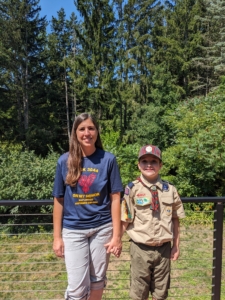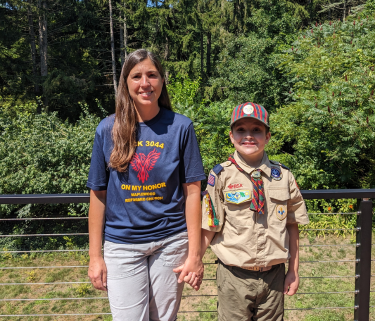Seclusion and Restraint: A Mother and Teacher’s Perspective
 Cassie is a mother, former educator, and co-founder of Michigan Advocates to End Seclusion and Restraint (EndSaR). She is a passionate advocate against the use of seclusion and restraint in schools, fueled by a lifetime of personal and professional experiences with these practices, which she hopes others can learn from.
Cassie is a mother, former educator, and co-founder of Michigan Advocates to End Seclusion and Restraint (EndSaR). She is a passionate advocate against the use of seclusion and restraint in schools, fueled by a lifetime of personal and professional experiences with these practices, which she hopes others can learn from.
Cassie’s first experience with seclusion and restraint happened in 2001 when she was still a teaching student. She took a long-term substitute position working one-on-one with a fifth grader whom the school had determined to be too aggressive to engage in his classroom.
Cassie and her student had a good relationship with no incidents. But one day, Cassie arrived at school and found the student had been secluded in a room after “getting aggressive” at breakfast. He was screaming, punching, and kicking at the window. Staff told her this was typical behavior and that she needed to keep him there until he calmed down. “I had never heard of such a thing in all my educational training,” says Cassie, “but I was very good at following instructions, so I did what they told me.”
The student spent hours in that room—and not long after that, he stopped showing up for school. Over 20 years later, Cassie says this experience still lives with her. “I know what was happening felt wrong, but I had no idea at the time what to do differently.”
Nearly 20 years went by for Cassie without another incident involving seclusion or restraint. And when it happened again, she didn’t experience it as a teacher—it was as a parent. The person impacted was her five-year-old son, Kai.
When Kai was two years old, Cassie noticed her son was different. He was incredibly bright and taught himself to read before preschool—but he was also very intense and craved Cassie’s attention, acting out if she focused on something other than him. These challenges followed Kai into kindergarten. Eventually, he was diagnosed with autism. They discovered later that he also has extreme difficulty following short, specific directions.
The diagnosis gave Kai access to services and supports, and he received an individualized education plan (IEP). The teachers started with this plan and would ask Kai to sit quietly for five minutes, but he would get angry, and they would start the five minutes over again. This led to him being put in a seclusion room for the first time at just five years old.
 Between August and December of his first-grade year, Cassie recorded that six-year-old Kai was sent for “time away” around 100 times, much of which took place in a seclusion room.
Between August and December of his first-grade year, Cassie recorded that six-year-old Kai was sent for “time away” around 100 times, much of which took place in a seclusion room.
“It was a little, closet-sized room in an office… The one skinny window was covered with paper so [Kai] couldn’t see who was outside… Sometimes the door was fully closed, but many times, the school would have the door a little open but blocked so he couldn’t get out. When it was a little open, the school did not consider it seclusion.”
Eventually, a behavioral specialist was consulted, and they advised the use of restraints. This moment was a revelation and turning point for Cassie, both in terms of Kai’s education and her advocacy.
Cassie realized that the school system wasn’t going to work for Kai, because staff didn’t understand that he wasn’t in full control of his actions; he was struggling to manage his nervous system and sensory challenges. These experiences ultimately led Cassie to homeschool Kai. They also inspired her to start Michigan Advocates to End Seclusion and Restraint so that no other students and families must go through what her family did.
Parents and teachers often believe that seclusion and restraint are needed to keep everyone safe. However, Cassie believes that it makes everyone less safe:
“Right now, teachers set expectations for students and expect students to meet them. If they don’t, the system perceives the student as a problem. There is often a lack of awareness of the adult role in co-regulation as a tool for preventing unwanted behaviors. This environment causes parents to feel like they are part of the problem when they offer alternative ways to care for their kids, and this mindset is also part of what fuels the ‘pre-school to prison’ pipeline, where students are pushed out of the classroom and become much more likely to be introduced to the criminal justice system.
If we could work with students, their families, and mental health providers to identify the underlying causes of behaviors and resolve those issues, we could prevent most of these crises and issues from occurring. When this happens, everyone is safer.
To do this, we need to support our teachers in the classroom with training on data-driven best practices, developments in neuroscience and learning, and resources, including more personnel and help in the classroom. We need to get away from grading teachers on their classrooms’ behavior management and rewarding and punishing teachers based on the behaviors that students in their classroom display.”
How to Help Students With Disabilities
Teachers and schools need money to support students with disabilities. The Individuals with Disabilities Education Act (IDEA) was passed into law in 1975 to provide education services to kids with disabilities. Currently, Congress funds schools at less than 15 percent of their needed costs. We must fully fund special education—and general education—costs so that teachers and schools have the right resources to support the next generation of Americans.
We also need Congress to pass the bipartisan Keeping All Students Safe Act to establish safety standards and provide better training and oversight to ensure the safety of students and staff and prevent abuse and death. Sign our petition to support this important bill.








